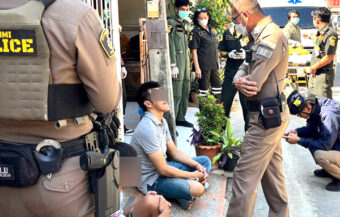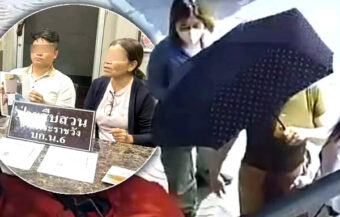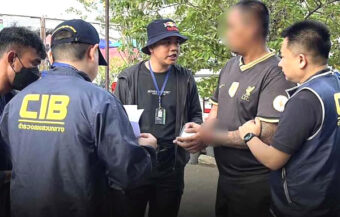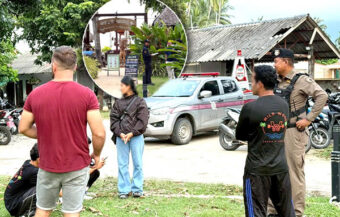A Suan Dusit economic opinion poll on Sunday appears to show a more resilient population with 32.31% of people saying they could survive for between 6 months and two years if economic restrictions were not lifted. It comes as the data is also showing Thailand with a remarkably low death rate from the COVID-19 virus compared to other countries at 0.88% despite having a low level of the population vaccinated.
Prime Minister Prayut Chan ocha called for unity across the political spectrum on Saturday when he predicted that the kingdom will emerge successfully from the COVID-19 challenge and would regain its economic momentum. He was on a visit to Samut Prakan and singled out the Public Health service for praise as he heralded the start of a sustainable recovery.
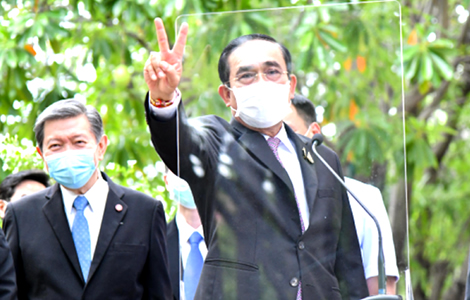
On Saturday, Thai Prime Minister Prayut Chan ocha made a call for unity in the country across the political divide and promised that the altered situation caused by COVID-19 would not only return to normal but that Thailand would find itself on the path to a more prosperous future.
His appeal comes as the opposition, last week, filed a censure motion in parliament against General Prayut, the Minister of Public Health Anutin Charnvirakul and four other ministers.
Visits on Saturday to new field hospital facilities in Samut Prakan set up by the Ministry of Defence
He made his comments as he visited newly opened state of the art field hospitals in Samut Prakan province where he praised officials and all those who played a part in setting them up including private sector firms.
He accepted the government had made mistakes but appeared confident that the Thai public health system would emerge with some credit from the current virus challenge.
‘The country will regain its momentum and drive for sure. Anything that has been wrong, delayed, needs to be made better or corrected will be done to create a stable and healthy public health system in the future. Thailand will come through the crisis and we will be able to achieve the sustainable revival of the country soon,’ General Prayut said.
The PM was visiting the Phramongkutklao Hospital and the Sanam Saeng Naekjai Hospital where the new facilities have been put in place by the Ministry of Defence.
The government leader is also the Minister of Defence in his second government since its appointment in July 2019.
Special air conditioning facilities with an external source for each bed in the wards of new hospital
At the Sanam Saeng Naekjai Hospital, Prayut was shown specially constructed air conditioning facilities at the hospital which provided a separated external source of air for each bed in the wards.
It also had a negative air pressure system to reduce the danger of infection being spread at the facility.
General Prayut was also told that the air in the system was especially filtered and disinfected to ensure staff and patients are working in the cleanest and most hygienic environment possible.
Worst of the current COVID-19 wave may be behind the country according to a Centre for Covid-19 Situation Administration (CCSA) spokeswoman
The PM made his comments about the health service as a Centre for Covid-19 Situation Administration spokeswoman, also on Saturday, suggested the worst of the current COVID-19 wave may have passed its peak.
It also comes as Thailand appears to have a markedly lower death rate than most countries in the world from the virus despite the relatively low rate of vaccination achieved.
Thailand has a relatively low death rate from the disease compared to other countries across the world
The current figures show 1,030,281 infections leading to 9,087 deaths which is a 0.88% death rate coming at a time when only 8.3% of the population is fully vaccinated.
Only Israel, which has led the world in rolling out vaccinations, shows a lower death rate from the disease among countries with large outbreaks at 0.69% with a corresponding 60.1% vaccination rate.
This can be compared to Sweden which never imposed a lockdown but which suffered a 1.31% death rate and now has 50.4% of the people vaccinated.
Meanwhile, Brazil, a country with a death rate of 2.79%, more than three times the death rate seen in Thailand, has 25.2% of the population vaccinated. This is similar to Colombia with a 2.54% death rate and a 28.1% vaccination rate.
The United States, the country with the highest number of deaths and infections has ended up with a 1.68% death rate which is 91% more than Thailand has seen, even though that country has a 51.9% vaccination rate.
CCSA spokeswoman Apisamai Srisangson calls for caution but says the curve has lowered since a mid-August peak of about 23,000 infections
On Saturday, Ms Apisamai Srisangson, speaking at the daily Centre for Covid-19 Situation Administration (CCSA) press conference, cautiously expressed the view that the curve of infection had begun to level off and has passed its peak.
This is a view repeated also by leading doctors who are suggesting Thailand’s Delta variant driven wave, which began to take off in mid-June but was first detected at the end of May at a building site in Bangkok’s Laksi district, had peaked between August 13th and August 16th with infections in the order of twenty-three thousand per day.
On Saturday, Ms Apisamai said the rate of infection in Bangkok was now 41% while in the hardest-hit provinces, it was 59%.
She warned that the public must remain circumspect, explaining that new research and evidence suggested that vaccinated people, while protected from serious illness or death, can carry the infection.
Infections and fatalities are expected to level off and lower as official praised Bangkok’s health measures
‘There are signs that the number of infections and fatalities are about to level off,’ Ms Apisamai revealed. ‘We hope the situation is getting better, and we must not make a mistake in this critical period.’
The CCSA spokesperson paid tribute to the programmes run by the Ministry of Public Health promoting community and home isolation for those infected with the disease in Bangkok who had less severe symptoms explaining that this has freed up 9,426 bed places in the capital.
She referred to community isolation centres pointing out that 14 of them could provide RT-PCR testing, the polymerase chain reaction testing which can detect genetic material from the virus while 7 of the facilities were capable of handling more than 1,000 patients at any one time.
Vaccinations have played a key role in breaking the back of the current outbreak says top doctor
The prospect of the outbreak having passed its peak was confirmed by Dr Kampanat Porn-yotkrai who is a well known social media commentator in the kingdom on the COVID-19 situation and who also works as a urologist.
He specifically identified the country’s vaccination programme, which has been focused on Bangkok, as playing a part in helping to break the back of the wave.
Even though there has been sharp and ongoing criticism of the sluggish and at times shambolic vaccine rollout in the kingdom, the country currently is recording a vaccination rate of 36 doses per 100 people compared to Brazil which is desperately trying to control one of the most severe and deadly COVID-19 outbreaks in the world at 82 doses per 100.
Stronger vaccination drive expected as Thailand moves towards a mid-October reopening to foreign tourism with an end in sight to the Covid 19 crisis
The figures to Friday, August 20th, show the US on 108.15, the United Kingdom on 131.21, China 134.5 and Singapore on 148.87 with the United Arab Emirates (UAE) leading the way at 178.79.
The outcome for Thailand with such a low vaccination rate is quite exceptional although it has come at a very high economic price.
Dr Kampanat, on Saturday, warned however that the current outbreak may still take 2 to 3 months to return to levels before it flared up which could see elevated levels of infection past October 1st with October 15th having been set as the date for Thailand to open back up to the rest of the world to help recover the kingdom’s dormant foreign tourism industry.
The country’s vaccination programme has only delivered over 25.2 million doses to over 18 million people but officials are confident that a vaccination rate of 500,000 doses per day can be reached in the future when international orders of vaccine products begin to be delivered.
Still more infections and heartache to come
However, before this, Dr Kampanat warned that Thailand could yet see between two and three thousand more fatalities from the disease.
‘There will be about 300,000 to 400,000 new infections during the downward trend,’ he said. ‘Based on statistics, fatalities will peak after two weeks, so there could be 2,000 to 3,000 fatalities before this wave is finally over.’
The glimmers of hope are coming as daily and violent protests are being witnessed on the streets of Bangkok with heartbreaking stories of tragedy as the virus lockdown and the deteriorating economic situation has strongly impacted the less well off in Thai society and the vulnerable.
Sunday poll appears to show a more resilient public economically than broader data and news reports
On the other hand, a Suan Dusit poll published in the Bangkok Post on Sunday conducted among 1,274 people, appeared to suggest the public was coping surprisingly well with the situation with 37.3% of respondents telling interviewers that they had enough financial resources to survive for up to three months with no less than 62.53% suggesting they could survive for anywhere between three months and two years.
This was broken down as 30.32% for three to six months, 19.68% from six months to one year and 12.63% of people who told interviewers that they can hold out for one to two years.
Over 85% of people said that they had employment income, at this time, in the nationwide survey
The poll cited a figure of 85.37% who said they have income from both main and supplementary jobs and that such income has helped them survive while 46.78% said they had made use of savings, 44.34% saying they had received government supports and 26.26% saying that they had resorted to using funds from credit cards and other financial facilities.
Over 25% said they had borrowed from friends and family.
Figures from 2017, compiled by German consumer data firm Statista, showed that only 10% of Thai adults possessed a credit card while Bank of Thailand figures to June 2021 showed that over 24 million credit card accounts existed with a total liability of ฿410.889 billion in the country.
Call for lower water and electricity bills
Over 77% of Thais have access to some sort of banking facility while a 2016 survey by the Bank of Thailand showed that only 26.8% of Thais had access to a formal bank loan from a commercial bank or financial service provider compared to 27.8% in 2013.
The survey showed that 86.41% of people would like to see the government prioritise support efforts to the population at this time, involving lower water, electricity and fuel costs with 71.64% calling for a standard and equal rate of compensation for all citizens with 61.85% calling for an extended debt moratorium programme.
Join the Thai News forum, follow Thai Examiner on Facebook here
Receive all our stories as they come out on Telegram here
Follow Thai Examiner here
Further reading:
Rising prospect of GDP contraction for 2021 may see government breach the legal public debt limit
Economic fears rising as Thailand faces a bigger crisis than 1997 with rising job losses and debt
Baht falling with confidence in Thailand waning as foreign tourism closure and virus drive funds out
Central bank to lower GDP growth forecast as its attention turns to private sector debt management
Loan bill passes but Thai economic prospects are not bright with a 1.8% 2021 GDP gain predicted
IMF urges government to loosen nation’s purse strings as finances tighten with the tax take down
Failure to pass the ฿500 billion borrowing decree could lead to the dissolution of parliament
Industry leaders and central bank all warn that foreign tourism must return to avoid a collapse
Fact – only 6,556 visitors arrived in Thailand last month compared to 3.95 million in December 2019
Desperate foreign tourism business concerns are clinging to straws as they try to survive the crisis
Challenge of the virus and closure to tourism leads to major long term changes in the Thai economy
Finance Minister says economy must pivot away from tourism with a switch to S-Curve industries
Strengthening baht predicted as investors bet on a reopening of Thailand to mass tourism in 2021
Thailand facing a credit crunch as 3rd virus wave craters the kingdom’s economic recovery plans
3rd virus wave now spells not just economic loss but financial danger as kingdom’s debt level rises
Still time to avoid lockdown says Health Minister as 3rd virus wave dwarfs all infections to date
Thai economy is still in reverse despite rising confidence and a virus threatening a 3rd wave
Reopening of Phuket still not officially approved although it is the ideal test for a broader move
Minister urged not to be afraid to borrow in 2021 as fears grow for a quick foreign tourism revival
Economy to rebound as the year progresses driven by exports and a return of mass foreign tourism
Door closing on quick foreign tourism return as economic recovery is delayed to the end of 2022
Fact – only 6,556 visitors arrived in Thailand last month compared to 3.95 million in December 2019
Desperate foreign tourism business concerns are clinging to straws as they try to survive the crisis
Finance Minister says economy must pivot away from tourism with a switch to S-Curve industries











